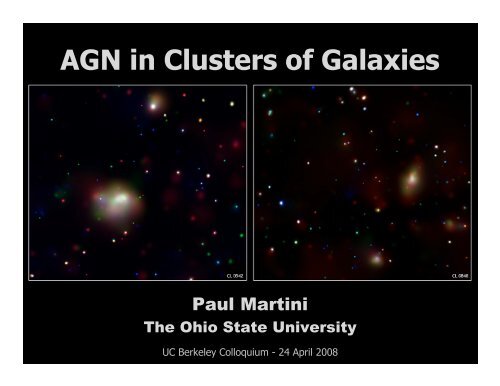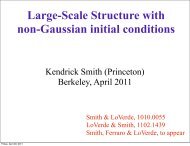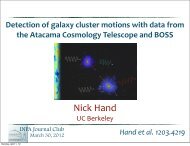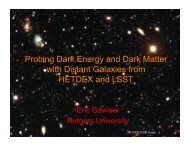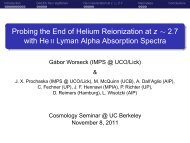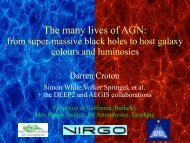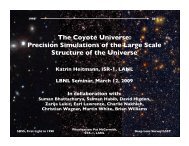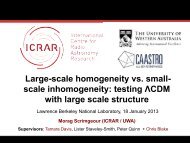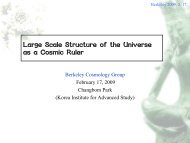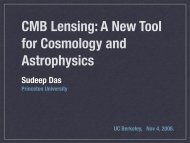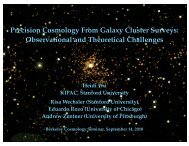AGN in Clusters of Galaxies - Berkeley Cosmology Group
AGN in Clusters of Galaxies - Berkeley Cosmology Group
AGN in Clusters of Galaxies - Berkeley Cosmology Group
You also want an ePaper? Increase the reach of your titles
YUMPU automatically turns print PDFs into web optimized ePapers that Google loves.
<strong>AGN</strong> <strong>in</strong> <strong>Clusters</strong> <strong>of</strong> <strong>Galaxies</strong><br />
Paul Mart<strong>in</strong>i<br />
The Ohio State University<br />
UC <strong>Berkeley</strong> Colloquium - 24 April 2008
Carnegie:<br />
John Mulchaey<br />
Dan Kelson<br />
Alex Athey<br />
Southampton:<br />
Christian Kaiser<br />
Arizona:<br />
Ann Zablud<strong>of</strong>f<br />
Collaborators<br />
The Ohio State University:<br />
Timothy Arnold<br />
Jonathan Bird<br />
Jason Eastman<br />
Greg Sivak<strong>of</strong>f<br />
Harvard-Smithsonian CfA:<br />
Eunhyeuk Kim
Cluster Physics & the<br />
Cool Core Problem<br />
<strong>Clusters</strong> <strong>of</strong> galaxies are filled<br />
with hot (T~10 8 K) and diffuse<br />
(n~10 -3 cm -3 ) gas<br />
The gas <strong>in</strong> the core should<br />
radiatively cool <strong>in</strong> less than a<br />
Hubble time, but not enough<br />
cool gas is observed<br />
Burns (1990) noted most cool<br />
cores harbor powerful <strong>AGN</strong><br />
Fabian et al. (2005); Schmidt et al. (2002)<br />
Perseus
Hydra A<br />
<strong>AGN</strong> Feedback Observed<br />
X-ray Radio<br />
Cavities <strong>in</strong> the hot <strong>in</strong>tracluster gas formed by radio jets<br />
McNamara et al. (2000)
Black Hole Evolution<br />
Rapid black hole growth<br />
produces an <strong>AGN</strong><br />
An <strong>AGN</strong> requires:<br />
• trigger<strong>in</strong>g<br />
• fuel supply<br />
The cluster environment<br />
<strong>of</strong>fers an opportunity to<br />
test this picture <strong>in</strong> the<br />
context <strong>of</strong> galaxy evolution<br />
Hopk<strong>in</strong>s et al. (2005); Fan et al. (2001)
Galaxy Evolution <strong>in</strong> <strong>Clusters</strong><br />
Ram Pressure<br />
Stripp<strong>in</strong>g:<br />
Kenney et al. (2004)<br />
ICM pressure:<br />
P r ~ r e v 2<br />
Restor<strong>in</strong>g force:<br />
F/A = 2πGσ sσ g<br />
For typical galaxies,<br />
v~1000 km/s can<br />
strip their cold gas<br />
Sun et al. (2004)
Galaxy Evolution <strong>in</strong> <strong>Clusters</strong><br />
Do these processes similarly affect <strong>AGN</strong> evolution?<br />
From Treu et al. (2003)
Lifetime <strong>of</strong> Radio <strong>AGN</strong><br />
<strong>in</strong> <strong>Group</strong>s & <strong>Clusters</strong>
Demographics<br />
Berl<strong>in</strong>d et al. (2006)<br />
SDSS catalog<br />
3945.1°<br />
57,138 galaxies to z=0.1<br />
Complete to M r= -19.9<br />
Magnitude cut:<br />
M r ≤ -22.0 ~2000 groups<br />
Cross-correlate central<br />
group/cluster galaxy<br />
with FIRST<br />
Bird, Mart<strong>in</strong>i, & Kaiser (2008)
Fraction <strong>of</strong> Sources < Projected Jet Length<br />
52 jets <strong>in</strong> 2,020 central galaxies<br />
Projected Jet Length [kpc]
Mock Catalogs<br />
Create a mock catalog <strong>of</strong> 100,000 jets<br />
Assign each a random age up to t max<br />
Calculate how much they have faded as they<br />
age with the Kaiser et al. (1997) self-similar<br />
analytic model for jet evolution (FRIIs)
Model Jet Structure<br />
Jet <strong>of</strong> relativistic fluid from the <strong>AGN</strong><br />
Strong magnetic field <strong>in</strong> cocoon around jet shock<br />
produces synchrotron emission<br />
Kaiser & Alexander (1997)
Radio Power at 1.4 GHz [w/Hz/sr]<br />
Lum<strong>in</strong>osity Evolution <strong>of</strong> a Jet<br />
Age = 10 6 yr<br />
10 7<br />
Inverse Compton<br />
scatter<strong>in</strong>g <strong>of</strong>f CMB<br />
Jet Length [kpc]<br />
Adiabatic losses<br />
10 8
Mock Catalogs<br />
Create a mock catalog <strong>of</strong> 100,000 jets<br />
Assign each a random age up to t max<br />
Calculate how much they have faded as they<br />
age with the Kaiser et al. (1997) self-similar<br />
analytic model for jet evolution (FRIIs)<br />
Constra<strong>in</strong> the <strong>in</strong>itial power distribution to<br />
match the local RLF (Sadler et. al 2006)<br />
Redshift distribution matches the groups<br />
Random projection on the sky<br />
Flux, size must meet FIRST selection
Fraction <strong>of</strong> Sources < Projected Jet Length<br />
t max =10 6 years<br />
10 7<br />
Projected Jet Length [kpc]<br />
10 8<br />
Bird, Mart<strong>in</strong>i, & Kaiser (2008)
Radio Lifetime<br />
10 7 yr lifetime agrees well with estimates<br />
from the growth <strong>of</strong> X-ray cavities (~R/c s)<br />
The FRII duty cycle is 10 9 yr
Distribution <strong>of</strong><br />
<strong>AGN</strong> with<strong>in</strong><br />
<strong>Clusters</strong>
Spectroscopy <strong>of</strong> Candidates<br />
Magellan 6.5m Telescopes LDSS Multi-Object Spectrograph<br />
Las Campanas Observatory, Chile
Spectroscopic Confirmation<br />
Identified a total <strong>of</strong> 57 cluster members with X-ray<br />
emission <strong>in</strong> eleven clusters <strong>of</strong> galaxies.<br />
Only 6/57 have <strong>AGN</strong> spectral signatures – almost all<br />
would not be classified as <strong>AGN</strong> <strong>in</strong> a purely<br />
spectroscopic survey<br />
Mart<strong>in</strong>i et al. (2006)
Sources <strong>of</strong> X-ray Emission<br />
1. Accretion onto supermassive black holes<br />
• evidence that galaxies reta<strong>in</strong> cold gas<br />
• can easily produce L X>10 42 erg/s<br />
2. Low mass X-ray b<strong>in</strong>aries<br />
• can produce L X < 10 41 erg/s <strong>in</strong> massive galaxies<br />
3. Hot X-ray halos<br />
• <strong>in</strong>terest<strong>in</strong>g if still present <strong>in</strong> cluster ellipticals<br />
• may be as lum<strong>in</strong>ous as L X ~10 41 erg/s<br />
4. Starbursts<br />
• rare <strong>in</strong> clusters and would exhibit strong [OII], etc.<br />
• the most extreme local starbursts have L X ~10 41 erg/s
<strong>AGN</strong> Identification<br />
LMXBs<br />
Hot Gas<br />
Jo<strong>in</strong>t<br />
Sivak<strong>of</strong>f et al. (2008)
Probability <strong>of</strong> False ID<br />
(expect
Centrally Concentrated <strong>AGN</strong><br />
Lum<strong>in</strong>ous <strong>AGN</strong> are<br />
more centrally<br />
concentrated<br />
50% with<strong>in</strong> 0.1 r 200<br />
Non-X-ray sources are<br />
all galaxies with M R
X-ray<br />
Sensitivity<br />
Abell 644<br />
(z=0.07)
Centrally Concentrated <strong>AGN</strong><br />
Implication: the most<br />
lum<strong>in</strong>ous cluster <strong>AGN</strong><br />
have been re-triggered,<br />
rather than are newly<br />
<strong>in</strong>fallen, gas-rich<br />
galaxies<br />
8 clusters stacked<br />
Mart<strong>in</strong>i et al. (2007)
<strong>AGN</strong> Fraction Measurement<br />
Abell 3128 (z=0.06)<br />
fA = NX (L>LX; MR
<strong>AGN</strong> Fraction vs. Environment<br />
>95% probability they are different<br />
Sivak<strong>of</strong>f et al. (2008)
Environment-Dependent<br />
<strong>AGN</strong> Evolution
Field <strong>AGN</strong> Downsiz<strong>in</strong>g<br />
Silverman et al. (2008)
The Butcher-Oemler Effect<br />
Butcher & Oemler (1984)
<strong>AGN</strong> <strong>in</strong> z>0.5 clusters
An <strong>AGN</strong> Butcher-Oemler Effect<br />
Factor <strong>of</strong> ~15 <strong>in</strong>crease<br />
<strong>in</strong> the cluster <strong>AGN</strong><br />
fraction<br />
Due to systematics,<br />
this is likely an<br />
underestimate<br />
3 <strong>AGN</strong><br />
8 <strong>AGN</strong><br />
11 clusters 4 clusters<br />
Eastman et al. (2007) + Sivak<strong>of</strong>f et al. (2008)
Comparison to Field <strong>AGN</strong><br />
More pronounced than<br />
the field evolution<br />
(Ueda et al. 2003)<br />
Evidence for<br />
environmentdependent<br />
<strong>AGN</strong><br />
downsiz<strong>in</strong>g<br />
3 <strong>AGN</strong><br />
8 <strong>AGN</strong><br />
11 clusters 4 clusters<br />
Eastman et al. (2007) + Sivak<strong>of</strong>f et al. (2008)
<strong>AGN</strong> and SFR Coevolution?<br />
Rate <strong>of</strong> evolution is<br />
consistent with blue<br />
galaxy fraction<br />
Do <strong>AGN</strong> quench star<br />
formation?<br />
Does star formation<br />
quench <strong>AGN</strong>?<br />
f B + <strong>of</strong>fset<br />
Eastman et al. (2007) + Sivak<strong>of</strong>f et al. (2008)
Summary<br />
The FRII lifetime is ~10 7 yr, duty cycle is ~10 9 yr<br />
More lum<strong>in</strong>ous <strong>AGN</strong> (>10 42 erg/s) are more centrally<br />
concentrated, suggestive <strong>of</strong> retrigger<strong>in</strong>g<br />
The <strong>AGN</strong> fraction <strong>in</strong> clusters is higher than expected:<br />
f A (L X > 10 41 erg/s, M R


